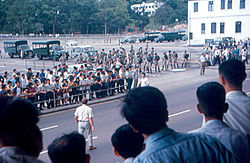Hong Kong 1967 Leftist riots
| Hong Kong 1967 riots | |
|---|---|

Confrontation between rioters and the Hong Kong Police Force
|
|
| Date | May - December 1967 |
| Location | Hong Kong |
| Methods | Demonstrations, strikes, assassinations, planting of bombs, |
| Status | Leftists failed to take over Hong Kong |
| Casualties | |
| Death(s) | 52 |
| Injuries | 802 |
| Arrested | 1936 |
| Hong Kong 1967 Leftist riots | |||||||||||||
| Traditional Chinese | 六七暴動 | ||||||||||||
|---|---|---|---|---|---|---|---|---|---|---|---|---|---|
|
|||||||||||||
| Transcriptions | |
|---|---|
| Hakka | |
| Romanization | Luk5 Cit5 Bau4tung4 |
| Yue: Cantonese | |
| Yale Romanization | Luhk Chāt Bouh Duhng |
| Jyutping | Luk6 Cat7 Bou6dung6 |
Hong Kong 1967 Leftist riots refers to the large-scale leftist riots between pro-communists and their sympathizers, and the establishment.
While originating as a minor labour dispute, the tensions later grew into large scale demonstrations against British colonial rule. Demonstrators clashed violently with the Hong Kong Police Force.
Instigated by events in the People's Republic of China (PRC), leftists called for massive strikes and organised demonstrations, while the police stormed many of the leftists' strongholds and placed their active leaders under arrest.
These riots became still more violent when the leftists resorted to terrorist attacks, planting fake and real bombs in the city and murdering some members of the press who voiced their opposition to the violence.
The initial demonstrations and riots were labour disputes that began as early as March 1967 in shipping, taxi, textile, cement companies and in particular the Hong Kong Artificial Flower Works, where there were 174 pro-communist trade unionists. The unions that took up the cause were all members of the Hong Kong Federation of Trade Unions with strong ties to Beijing.
The political climate was tense in Hong Kong in the spring of 1967. To the north of the British colony's border, the PRC was in turmoil. Red Guards carried out purges and engaged in infighting, while riots sponsored by pro-Communist leftists erupted in the Portuguese colony of Macau, to the west of Hong Kong, in December 1966.
Despite the intervention of the Portuguese army, order was not restored to Macau; and after a general strike in January 1967, the Portuguese government agreed to meet many of the leftist demands, placing the colony under the de facto control of the PRC. The tension in Hong Kong was heightened by the ongoing Cultural Revolution to the north. Up to 31 protests were held.
In May, a labour dispute broke out in an artificial flower factory in San Po Kong. This was owned by Li Ka-shing.Picketing workers clashed with management, and riot police were called in on 6 May. In violent clashes between the police and the picketing workers, 21 workers were arrested; many more were injured. Representatives from the union protested at police stations, but were themselves also arrested.
...
Wikipedia
